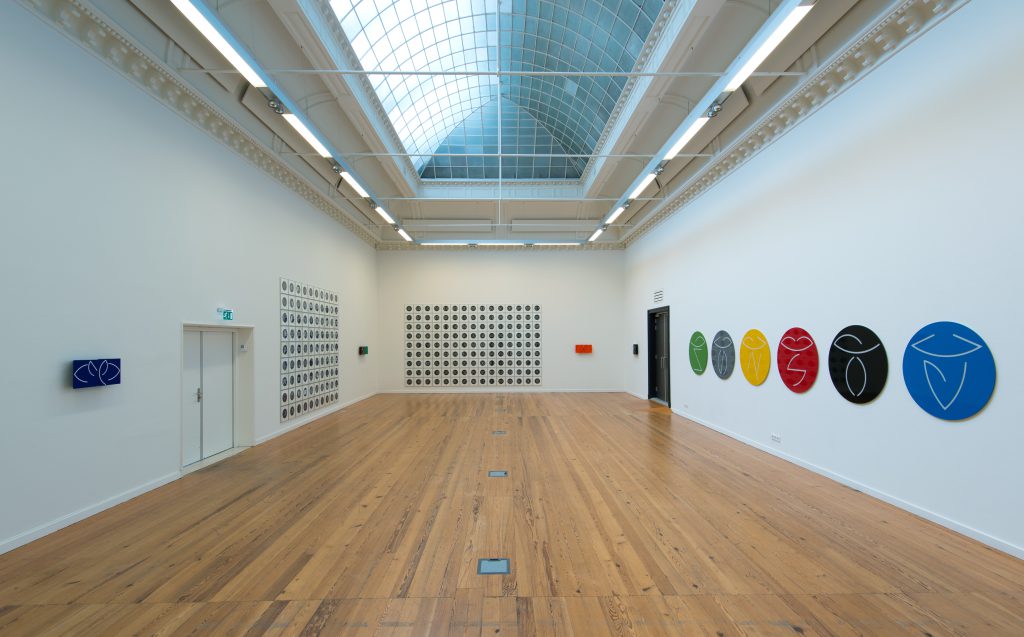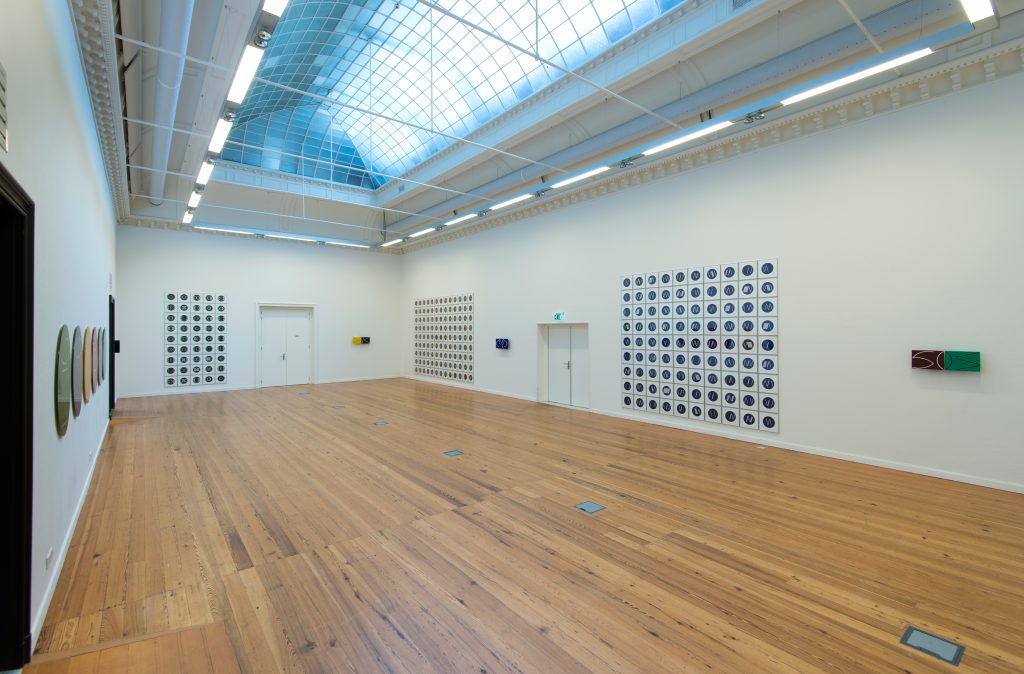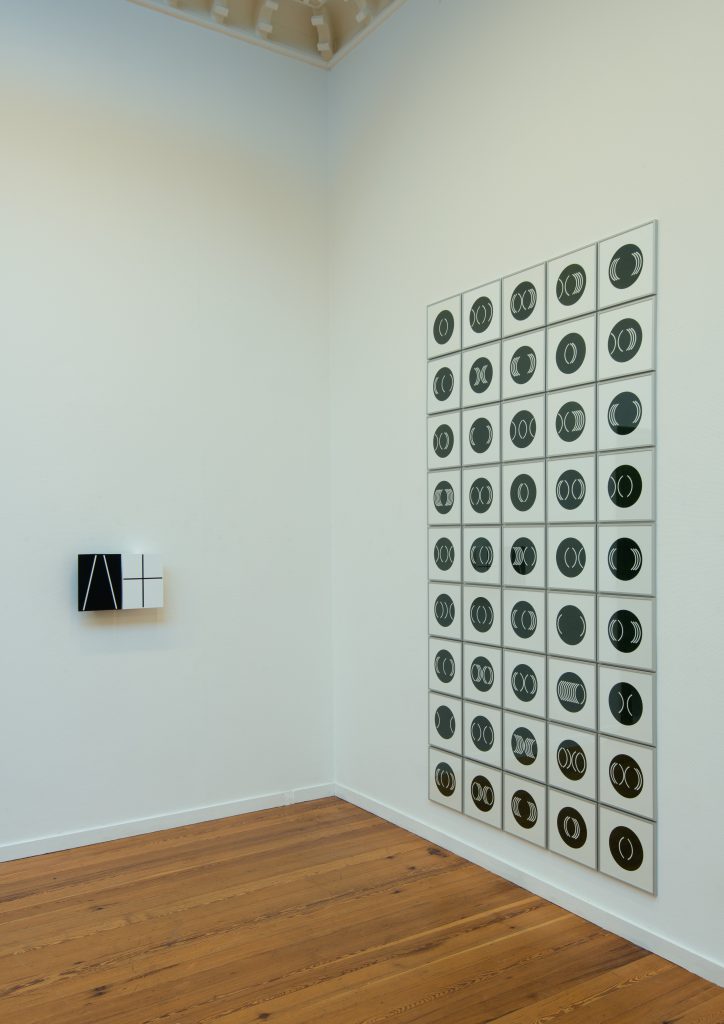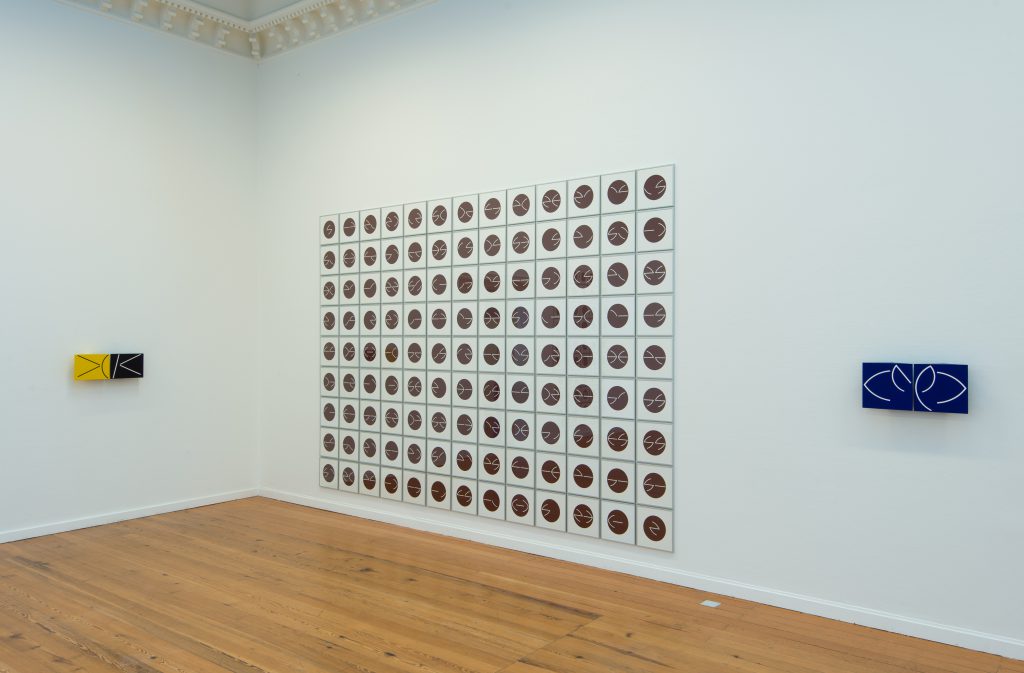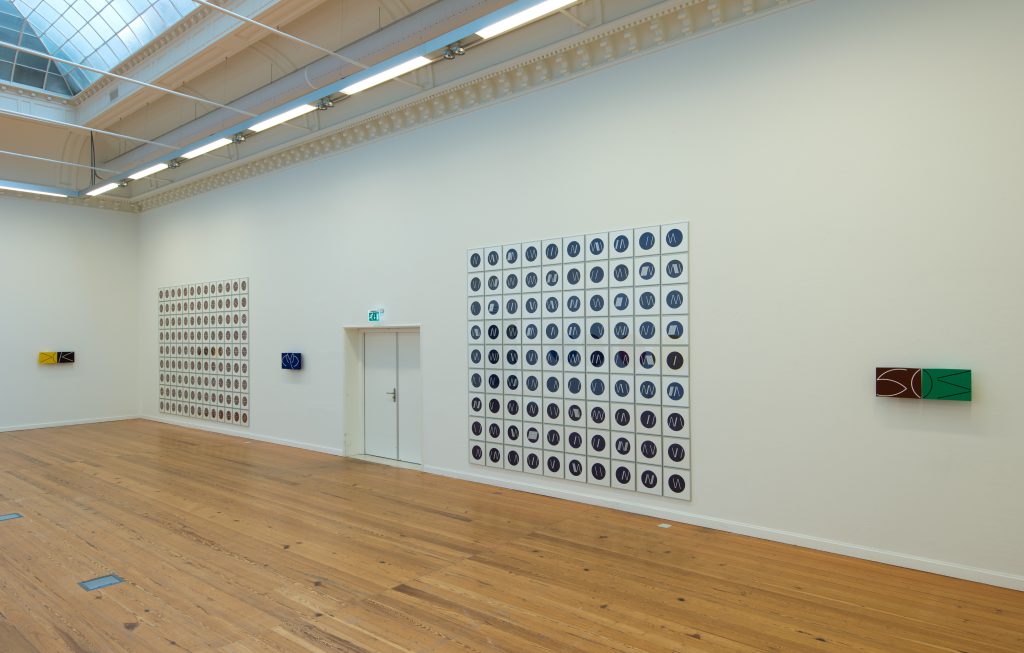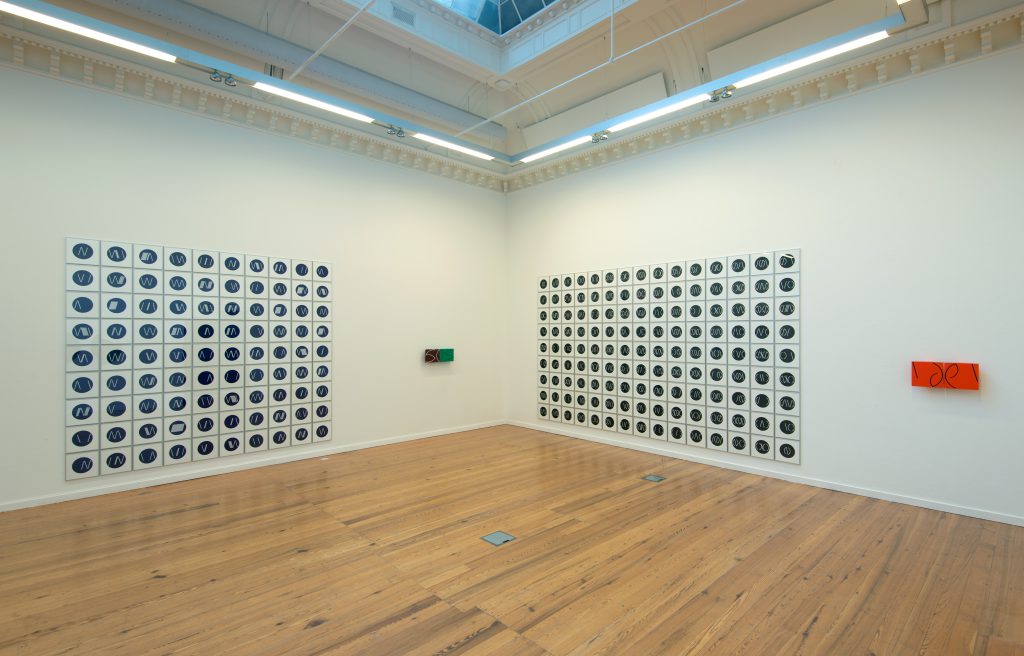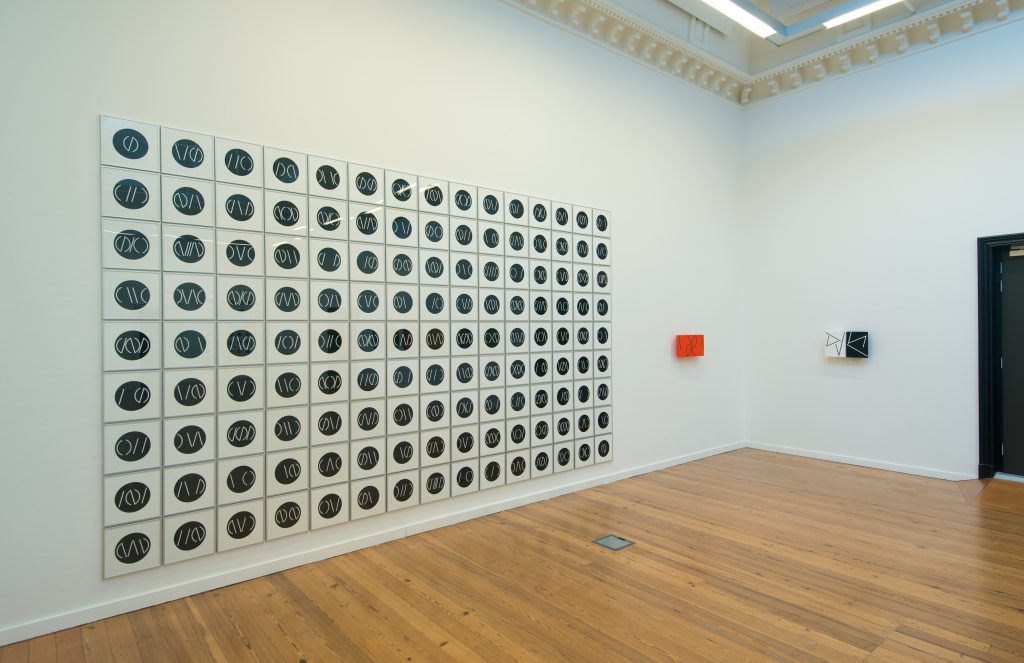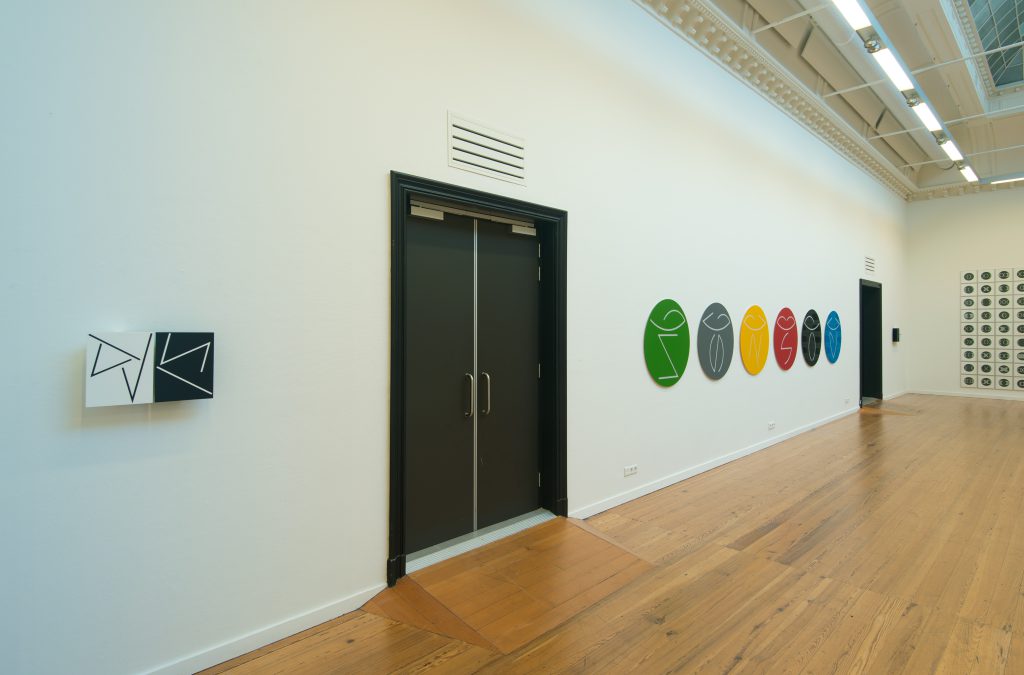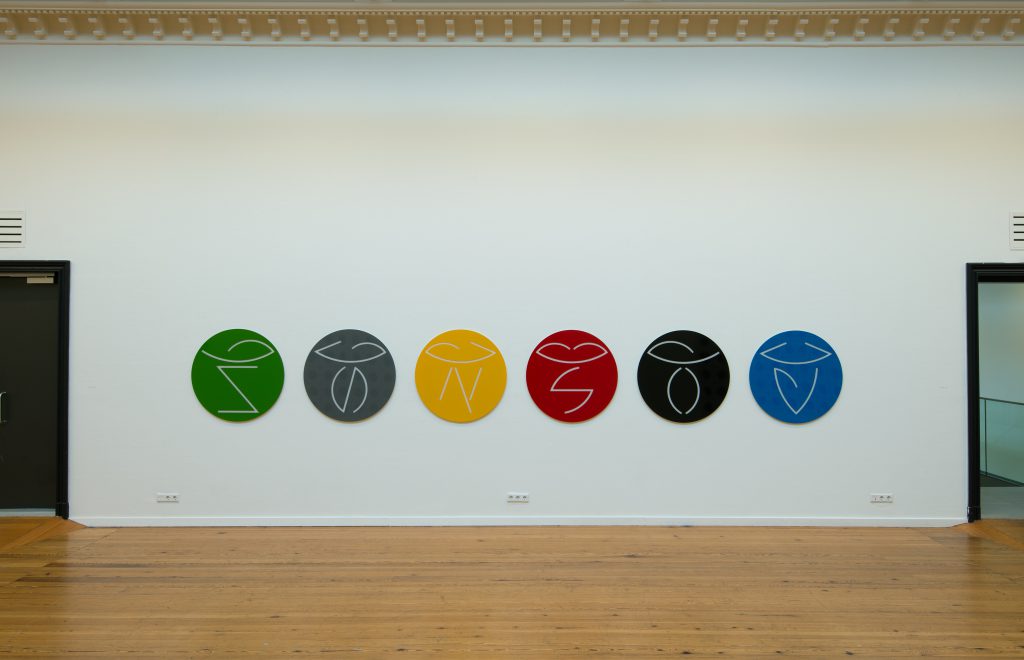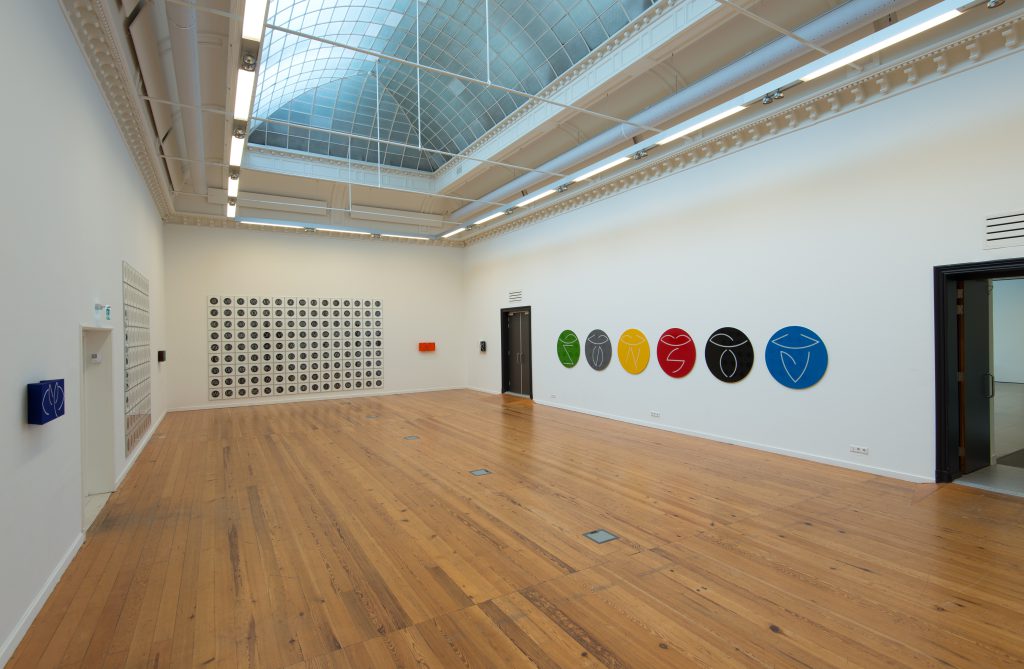Farewell exhibition at the Academy of Fine Arts Minerva, Groningen (NL), 2015. Photography John Stoel.
CIRCUMVOLUTION
Exhibition of the work of Ton Mars, Minerva Art Academy, De Koepelzaal, 25 August – 30 September 2015
Although this exhibition of work by Ton Mars coincides with his retiring as a teacher at Minerva Art Academy, it is not a ‘farewell exhibition’. As indicated by the title Cirkelgang (Circumvolution), the exhibition is one of the many circular movements in his work.
His oeuvre has a distinct and particular character. In 1986 the artist began developing ‘signs’ based on his monogram TM, composed out of straight lines and segments of circles, which could be associated with the alphabet. He then created compositions of his signs on three-dimensional, monochrome ‘panels’, adopting the structure of words and sentences, yet never yielding anything legible. In 1991 he gave these works – hovering between painting and sculpture – metaphorical titles connecting areas on earth with areas of the human mind. He had now discovered the most important principle of his work: the combination of image and language, and of mundane and spiritual realities. Yet he had also determined the direction his oeuvre would take – towards the transcendental.
Once Ton Mars had gathered all his ingredients, he could begin a game involving lines, shapes, colours, texts and metaphorical meanings, which is going on for a quarter of a century. He has thus given the family tree of abstract art another branch, onto which he added many side branches.
The artist harvests his ideas from his rich experience, although constantly converting them into his personal ‘sign language’ and drawing these into his artistic system. Every idea is developed in multiple guises, and every work goes on to yield new ideas. The results may appear to be strict and systematic, but actually his work is extremely playful, beginning with intuitive ideas, which only then are subjected to reflection. These brainwaves make the work privy to irregularity, thwarting viewers’ expectations and keeping their minds in motion.
In this exhibition, Ton Mars presents a sample of his oeuvre, selecting series, which are far from complete. The works on show belong to two major categories, the AB UNO/AD UNUM series of small diptychs, and the tondi series including Radical Expansions and The Initials. The end of the walls and the corners of the exhibition space are marked by six small three-dimensional diptychs, while the walls are covered by the six large tondi of The Initials and four fields of small tondi belonging to Radical Expansions.
Upon entering the space, immediately to the left of the door is a small, three-dimensional diptych, comprising a black panel and a white panel to which line-like signs have been applied. This diptych (oil on canvas) is part of the first AB UNO/AD UNUM series covering the Eurasian continent. All of the works in the series are entitled ‘Eén, Voorwoord’ (One, Preface), but translated into the various languages of the continent. The combination of the ground in either black or white with the signs opposite in tone is reminiscent of an open book, while also conjuring up associations with paired concepts such as day and night, mind and matter, profane and sacred. Yet the coherence of each diptych only becomes clear through the connection between the image and the language of the title in question.
After painting the initial ONE, with the numeral one in English as its title, Ton Mars decided to ‘make ones in all the languages of the world’. The resulting diptychs address the general image-language associations following the metaphorical connections of geographical and mental areas. By associating the ‘atmospheres’ of the diptychs with the spelling of the titles and their sound, it is possible to embark on imaginary trips to Eurasia and ‘become acquainted’ with various vistas, languages and worldviews. Some Ones are single, but most belong to a language family or are studies or ‘prefaces’ to larger diptychs.
The series of black and white Ones is prodigious, but matters do not end there. Displayed at the ends of the walls and in the corners are diptychs from two other AB UNO/AD UNUM series related to the African or American continent. While the Eurasian diptychs are vertical, the African ones are horizontal. Each panel has a different colour, with the lighter ground carrying black signs, and the darker ground white signs. The deep colours appear ‘African’, and the signs recall the eyes of African masks, giving the diptychs various ‘facial expressions’. Each work is connected to the numeral One in one of the many African languages, but ‘preface’ is absent, since these languages originally had no books.
This journey around the globe continues with the American diptychs assembled with square panels. These are monochrome and inscribed with white and black signs. Their compact shape and deep colours evoke American landscapes and art objects of Native Americans, whose languages provide the numeral one for the titles.
Although the series described here have not yet been completed, much has changed in the oeuvre of Ton Mars with the development of Radical Expansions in 2008. The small tondi in this series can be seen on the west, north and east walls of the exhibition space. They form extensive fields of ‘sign cells’, in dark green, dark red, dark blue and black respectively. Here, the biological microlevel of the living cell replaces the geographical macrolevel of continents as inspiration.
In making these small tondi (acrylic paint on paper behind glass), the artist relinquished – albeit temporarily – the three-dimensional shapes and bright colours of his earlier work. Only his sign language survived, since apparently this is the ‘substrate’ allowing all ‘life’ in this oeuvre to develop. Ton Mars now selects the strongest ‘stem signs’ and then subjects these to variation and mutation in the tondi. From the tondi, he creates ‘stem groups’ that together depict a kind of biological evolution.
This cell-biological inspiration meant a major departure from earlier work, but the signs of Ton Mars continued to refer to language in the new mutations too. Radical Expansions thus could engender new ‘linguistic’ works within the project The Names (From Name to Name), which arose when the artist associated a series of horizontally ordered tondi with a ‘name’. Names intrigue him due to the generally accepted supposition that names may say something essential about things and people. By ‘improving’ the signs and compositions of The Names, the artist was able to convey the justifiable doubt of this essentialist ‘naming’ of reality.
Ton Mars then isolated the initials from The Names, yielding the large tondi exhibited on the south wall. The independent tondi of The Initials series (high gloss paint on Plexiglas) are flat and reflective, making them strongly different from earlier work. Where the artist questioned the meaningful connections between names and things/persons in The Names, in The Initials he confirms the existence of something truly essential by using large, round shapes, stem signs (with diacritics) and primary colours. In all this the artist was inspired by art history.
In the Middle Ages, embellished initials were used as the initial letters of holy texts, while tondi were often associated with religious symbolism in architecture and painting due to their perfect, round shape. The art-historical inspiration for The Initials returned the work from the earthly/biological sphere of Radical Expansions to a spiritual/transcendental sphere. The two realities, conjoined earlier in a single work, have now been separated, but are exhibited together, making this dual track in the artist’s work more visible than ever.
Ton Mars thus constantly makes circling movements in his oeuvre. He circles around the various continents and spiritual areas, connects genres and kinds of art, images and languages, continually transforms earlier work, and literally uses segments of circles and tondi, thus allowing the concept circumvolution to refer to his oeuvre in both a literal and a metaphorical sense. However, he will never entirely close a circle. His circling should be understood to be part of a spiralling motion in a clear direction. Thus the series he is exhibiting here are still ‘under construction’, since even though he is leaving teaching, his work and spiritual development will long continue to revolve and evolve.
Katalin Herzog (August 2015). Translation: David Raats. For more information, please visit the website of Ton Mars, www.tonmars.com
